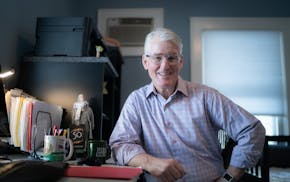The chaotic beginning of the COVID-19 pandemic seems like a long time ago, but Medtronic's Geoff Martha certainly remembers.
In March 2020, he was weeks from becoming chief executive of Medtronic and his cellphone was ringing with White House officials and others eager to talk to him.
The world desperately needed more critical care ventilators, the machines that help very ill people get oxygen into their lungs. Medtronic was a big player in the global ventilator market, and people wanted to hear from Martha how many more machines Medtronic could make.
Medtronic had been building 200 of them a week. By the end of last June, it was making about 1,000 a week in its own facilities with additional machines built by manufacturing partners. Even Elon Musk got involved in building Medtronic's ventilator parts.
Medtronic's staff also jumped on making its ventilator controllable from outside a patient's room so hospital staff wouldn't need to put on full protective gear and enter the room so often. Medtronic then provided this capability as a free upgrade to customers.
Medtronic's engineers built on top of a system that had been created to develop and test ventilators, yet this remote management system was the kind of software project that might ordinarily take a year or longer to complete. This one didn't even take eight weeks.
"What I learned is that when you focus on something like that, it's amazing what you can accomplish," Martha said in a recent interview. "Big companies like us, we are in every country, we're in so many different therapies and products, you can become unfocused. When you're trying to do too much, at the end you don't do enough. What we did on ventilators was quite amazing."
Nothing that Medtronic did, such as doubling staff at a plant almost overnight, sounded easy. But as remarkable as it was, lots of businesses had to really hustle in the last year and a half.
Some companies made health and safety products for the first time. Others had to figure out how to deliver their service without face-to-face contact. And almost every employer had people working differently, from sending some staff home to creating enough well-ventilated space between people in a facility for them to work without spreading the coronavirus.
You can't help but wonder how many CEOs thought, what if we hustled like that every day? Obviously everything that comes up at work can't be treated like a hair-on-fire emergency, but does a project that can be done in weeks really have to take a year?
To Martha, that ventilator story is one of focus and continuing ability of the historic mission of Medtronic to inspire the staff, but it's hard to clearly separate focus from speed or hustle. It just might take real focus, blocking out every distraction, to get something done quickly.
Martha had been thinking about this in his preparation to take over the company, as the Medtronic board had named him to succeed Omar Ishrak as CEO in August 2019 but gave Martha more than half a year before the formal transition.
In his meetings with colleagues during that period, Martha said they repeatedly came back to the idea that Medtronic just had to pick up the pace, to innovate more and to do it faster.
Moving fast is not a hallmark of a company that's grown to be the size of Medtronic, with more than $30 billion in revenue in its last fiscal year and more than 90,000 employees, including nearly 11,000 at its Fridley headquarters and elsewhere in Minnesota.
Martha's main idea was to turn one $30 billion business into a collection of 30 $1 billion businesses. The leaders of those 30 units would be turned loose to act like entrepreneurs, although they would be held strictly accountable for results.
When implemented, Medtronic only got to 20 separate businesses. While some are smaller than $1 billion in annual revenue and others considerably larger, Martha got the structure he wanted.
"The whole idea was get back to moving faster, like start-ups," he said. "We have to move faster, and so we started with what we are calling the new operating model, this structural change."
Big companies redoing their organizational charts can't really be considered news, but culture change is sure interesting, and that's mostly what this is about. Even senior managers have been asked to work differently, because if they want to let people down the organization make more key decisions they have to learn when to let go.
Another word Martha uses to talk about this change in the culture is simply competitiveness.
Smaller companies in the industry, with maybe just a single new product but with access to plenty of capital, continue to cause competitive problems for big companies like Medtronic. "Happens all the time," is the way Martha put it.
Medtronic, of course, has a long and storied history as an inventor of its own devices and therapies to make people healthy again.
The people of Medtronic are happy, he said, when the company boosts its research and development spending, even through a sharp downturn like it did in the last fiscal year.
On the other hand, there's also history of Medtronic coming up with some new product or therapy, opening up a market for it, and then not growing sales as fast as the market grows.
Even setting business goals needed a fix, Martha said. It once was high-fives all around if a Medtronic group beat its own financial target in the annual operating budget, or managed to grow sales over the prior year's. But what if competitors had just grown sales twice as fast?
"The challenge that we have on this is that there was a base of employees who kind of looked at things [as] black-and-white," Martha said. "How can we be mission-driven and be competitive at the same time? How can we be focused on market share and market development at the same time?
"And this is the part where I said, 'Look, great companies do both.'"

Schafer: What do you really need to retire?

Schafer: How doing business can be a bit more like Christmas morning

Schafer: There won't soon be another opportunity to rethink the I-94 corridor

Schafer: The fruits of Honeywell's long-game dedication to quantum computer now being seen


